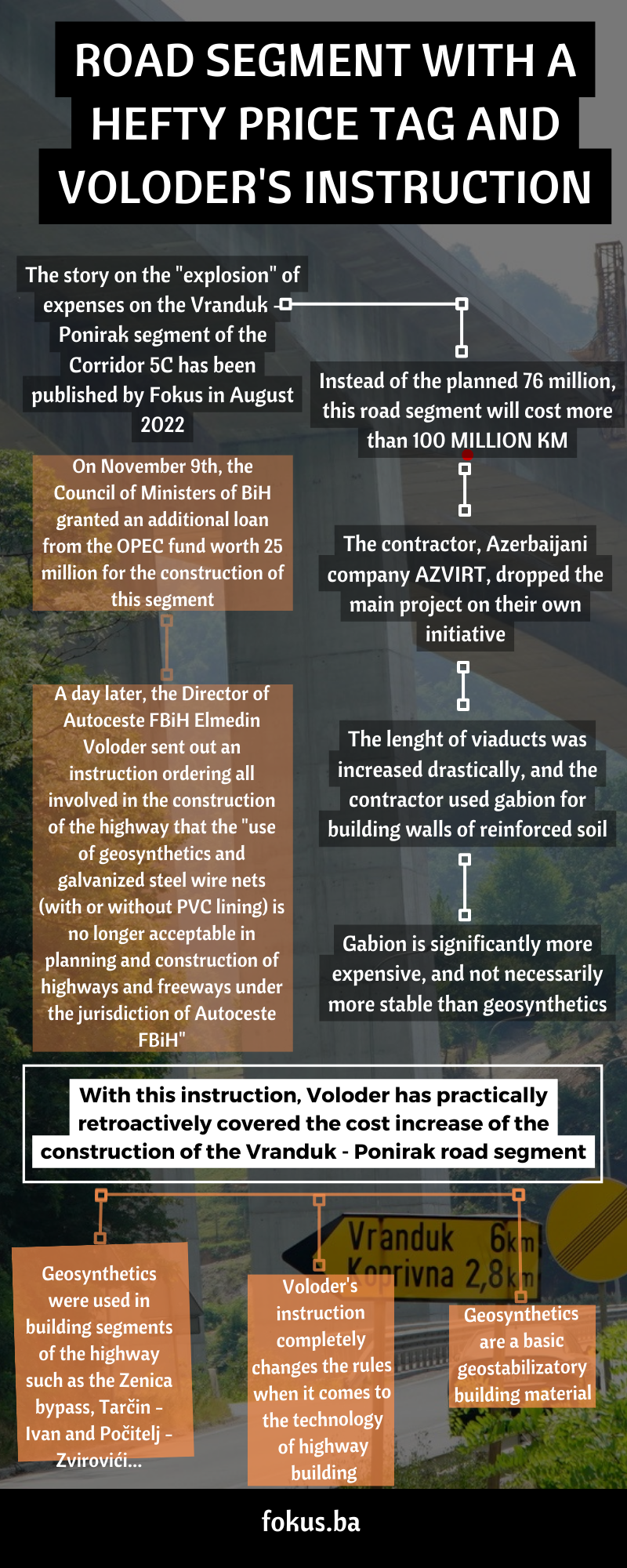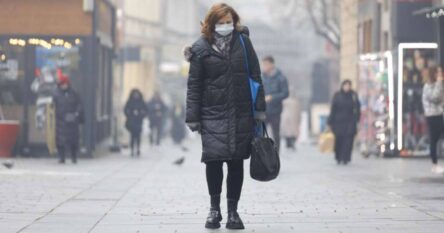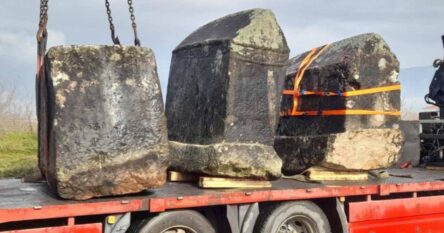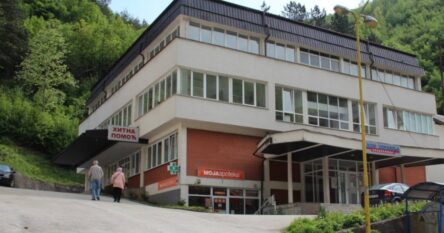Fokus.ba reveals
In whose interest is director Voloder changing the rules of higway building in Bosnia and Herzegovina?
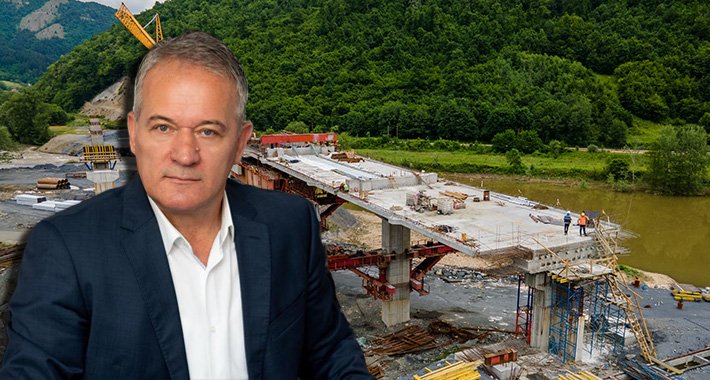
The Director of Autoceste FBiH has forbidden the use of geosynthetics in highways, a material standardized by the EU, without which modern construction is unimaginable. Everything is connected to huge mistakes in the construction of Vranduk – Ponirak highway which is under investigation.
The Director of Autoceste FBiH Elmedin Voloder issued, on November 10th 2022, a written instruction to construction services and documentation, and to companies involved in the construction of the highway on the Corridor 5C, which completely changes the rules when it comes to the technology of highway building, Fokus.ba finds out. The background of this decision, as we have found out, has criminogenic elements.
Written by: A. DUČIĆ/Fokus.ba
Voloder, namely, in this instruction, orders all of the involved in the construction that the “use of geosynthetics and galvanized steel wire nets (with or without PVC lining) is no longer acceptable in planning and construction of highways and freeways under the jurisdiction of Autoceste FBiH”.
Simply put: everything that was applicable so far, is not applicable anymore. Geosynthetics is the fundamental geostabilizing building material without which modern construction around the world is unimaginable, especially when it comes to roads and highways. On a number of highway roads on Corridor 5C which were built or are under construction in BiH, this material was used as it was standardized in 2004 by the European Union under the name EUROCODE 7. At the same time, it was standardized by the Institute for accreditation of BiH, under the mark BAS EN 13256:2018. Voloder's instruction goes against these standards.
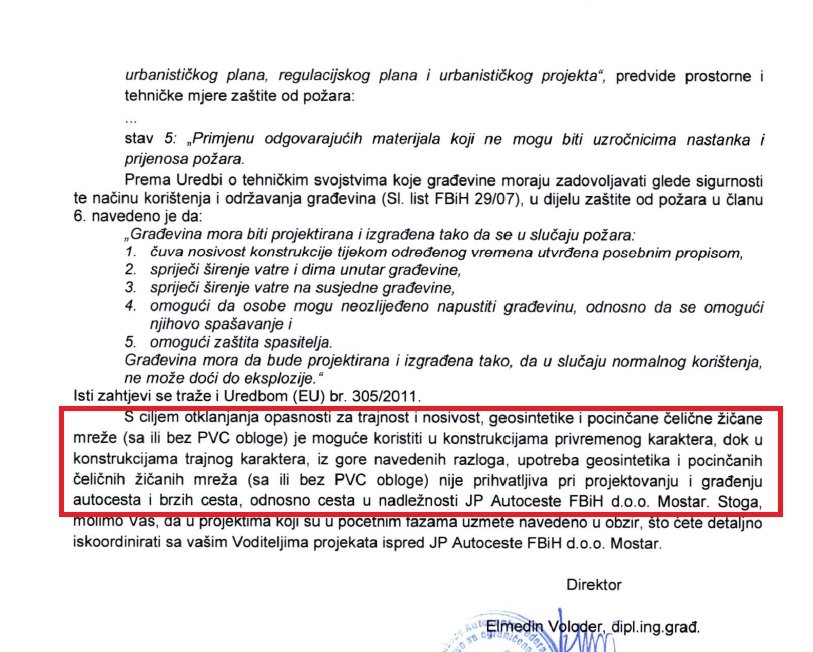
Voloder's instruction
This act, which is in possession of Fokus.ba, has alarmed the geotechnical professionals, but also a number of respected international companies which are the largest manufacturers of geosynthetics. They have reacted not long ago, sending letters to Voloder. They reckon that this is an irrational move which doesn't take facts about the ground and other road building characteristics into account. Additionally, the exclusion of constructors which use geosynthetics in building walls of reinforced soil is, to say the least, absolutely discriminatory and jeopardizes the rules of competition.
Some domestic contractors we contacted are also surprised by the instruction. They have already started planning to continue the project with calculated financial damage that they are facing. At the same time, the cost of construction of highways on Corridor 5C will go up.
However, according to data that we have acquired, this Voloder's instruction also has criminogenic elements and represents a continuation of suspicious practices started throughout the construction of the Vranduk – Ponirak road, which was reported by Fokus. They have been the object of investigation for a while.
As we published, one of the contractors on this road segment, the Azerbaijani company Azvirt, with the blessing of the Autoceste administration (Terzić and later Voloder), has conducted a redesigning of the most important sections of that road segment and largely strayed aside from the main project. That has, as we reported, lead to enormous escalation of the costs of building this segment. That segment is by far the most problematic when it comes to the explosion of costs, but also not respecting deadlines for construction.
What we didn't mention in our last story, is the information that the redesigned sections of the Vranduk – Ponirak road segment are the ones where 90 percent of the walls of reinforced soil are located. After the contractor declined to work according to the accepted main project of the company Integra from Mostar, they hired their own designers from Greece who made projects according to which the walls were to be built from gabion. After the redesign of a number of sections of the road segment by Autoceste FBiH, additional millions of euros were paid, which was pointed out, as we published, by the then Chief of Construction service Amir Šikalo.
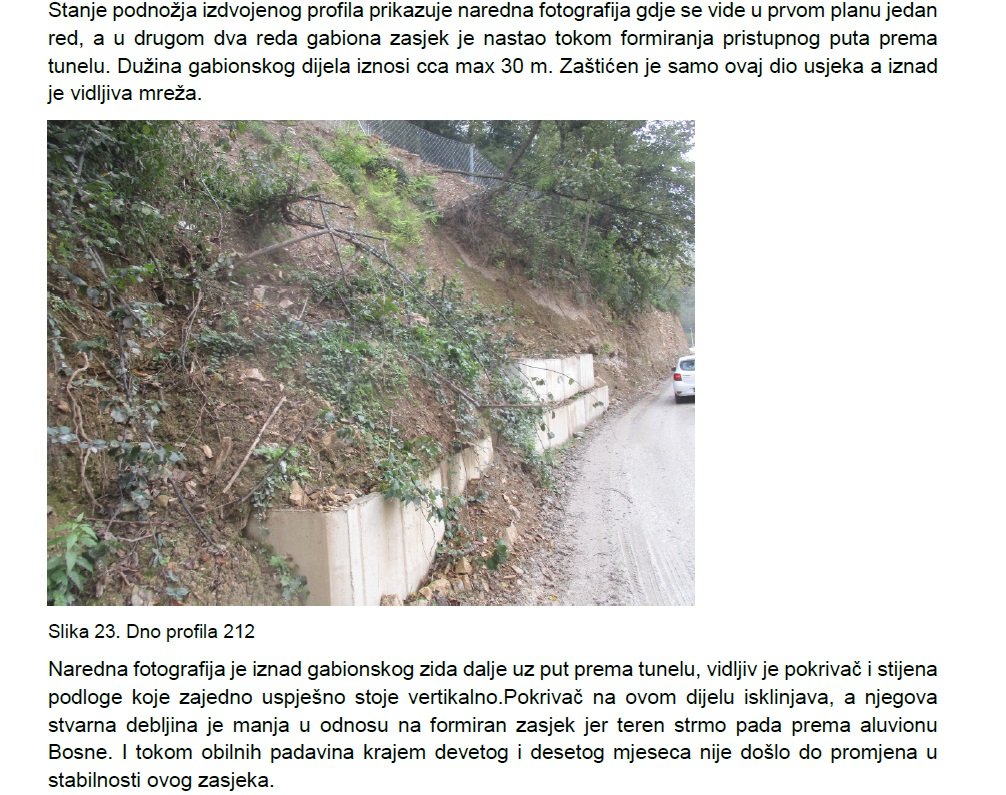
Field inspection has shown that Azvirt was building gabion walls
Šikalo sent an alarming note to the administration of Autoceste FBiH lead by Voloder in which he literally pointed out that the contractor Azvirt “gambled away the trust it was given for redesigning large portions of this subsection”. However, to no avail, Azvirt continued this method. Apart from the drastic lengthening of the viaduct, they used gabion (instead of geosynthetics) which is much more expensive, and not necessarily more stable, and, as Šikalo noted, increased the price of construction, also increasing their profits in the process.
The new instruction on complete elimination of geosynthetics from wall building from November 2022 was supposed to cover up the story on building the Vranduk – Ponirak segment. The additional problem is, as the contractors pointed out, that this practice continues throughout the whole Corridor 5C project in Federation of BiH!
In the act he made, which is in part contradictory, Voloder first praises the broad use of geosynthetic reinforcements, geonets or geotextiles, among other things, for their good mechanic characteristics and corrosion resistance.
But then, in this instruction, he suddenly points out that numerous geosynthetics are made of synthetic polymers and that “numerous sources in literature report on the negative effects of temperature increase on the mechanic characteristics of geosynthetics”. Furthermore, he emphasizes that they can be flammable in high temperatures. Steel is also problematic according to him, as he writes that heightened temperature may lead to lower strength (when the temperature tension in steel is higher than 400 degrees). Also, Voloder finds the galvanized steel nets problematic because of the “peeling of the zinc layer, which can reflect negatively on the anticorrosive protection”.
Voloder calls upon the Law on protection from fires and firefighting of FBiH for his argumentation, which dates back to 2009, more than 13 years ago! He also quotes the regulation on technical characteristics which buildings have to satisfy safety wise and the use and maintenance of buildings. This regulation dates back to 2007!
Fokus has come into possession of letters from Italian companies Tenax and Maccaferi which are among the largest manufacturers of geosynthetics in the world. The letters were addressed to Autoceste FBiH, namely to director Voloder.
In the act of the company Tenax, which took part in the construction of the Pelješac bridge and has colossal buildings in the Alps in its portfolio, it's written that according to their 30-year-long experience in geotechnical design, they are sure of the security of the use of this technique.
Commenting on the sources which Voloder quoted in his instruction, they state that some of those are not applied on projects which are in progress in BiH, while some others have been quoted inaccurately.
For example, as stated in Tenax's letter, quotes from some publications which Voloder used mention ground backfilling of 34.3 degrees Celsius related to the maximum outside temperature of 51.6 degrees Celsius.
– If that's realistic in the deserts of Arizona or Nevada, it's not in Bosnia and Herzegovina – states one of the comments by Tenax signed by director Piergiorgio Recalcati. By the way, as he states, all of the oversights in the literature quoted by Voloder have been a result of incorrect planning.
– A fire risk is mention, even though research the American Ministry of transport and the State administration for aviation has described the currently accepted methods of examination for quantification of behavior during burning. The examination is intended for designing fire resistant plastic. For aviation it makes sense, but for ground strengthening, it doesn't – states Tenax's letter. Additionally, it is noted that fear of fire might apply to buildings, but not embankments.
In the letter of the reputable Maccaferri, a company with a 140-year tradition, it is pointed out that buildings constructed using geosynthetics are a common and reliable solution in the modern times, because of their high performance, safety, cost effectiveness and better influence on the environment compared to traditional solutions.
In the act signed by the business manager of Maccaferri's Central Europe branch Luboš Lichy, it is stated that these materials are sturdier, more flexible and resistant compared to standard rigid buildings, especially in seismic conditions such as those in BiH. The aforementioned technique is in compliance with European standard EN 14 475 – Execution of special geotechnical works – reinforced filling.
– When it comes to your examinations on fire resistance, to be honest, we can't comply with the approach presented in Your letter. Following this logic, all infrastructural elements planned for JP Autoceste FBiH should take into account fire resistance, which is usually a design aspect related to buildings, not infrastructure – states the letter addressed to Voloder.
It's interesting that Voloder issued this instruction on November 10th 2022, just a day after the Council of Ministers of BiH granted Autoceste FBiH an additional loan from OPEC's fund worth 25 million for the construction of the segment Vranduk – Ponirak, where the costs escalated enormously, as we wrote earlier, because of, among other things, elimination of geosynthetics for building walls of reinforced soil.
Namely, the original contract worth for building the subsection Vranduk – Ponirak was 76.592.799 euro. Despite a very questionable escalation of expenditures which is under investigation, as well as a deviation from the main product, they have been granted an additional 25 million euro. By the way, geosynthetics as a material, has been used, among other instances, in building segments of the highway such as the Zenica bypass, Tarčin – Ivan and Počitelj – Zvirovići.
Mato Uljarević, president of the Association for geotechnics in Bosnia and Herzegovina, told us that he heard about Voloder's instruction, highlighting that it's not the best idea to publish decrees on whether something is allowed or not.
– At the end of the day, these geosynthetics have been used since 1969. Geosynthetics are practical materials. Easy to work with and very long lasting, if they are not exposed. That's why they are protected where there is a potential risk of fire. All in all, they are rarely left exposed. I think it's realistic to test the materials and show their pros and cons, and use them accordingly. But, I don't think it's fair to give out judgments so easily. Realistically speaking, every investor has a right to insist on something when planning a project. The project planner should actually be the one to do the risk analysis. The use of geosynthetics is not the same in every location. For example, the climate is different in Herzegovina and in central Bosnia, there is a big difference. Unfortunately, these instructions are published instead of analyzing more – explains Uljarević.
Experts who have been hired to build certain parts of the highway in FBiH told us they were shocked by the aforementioned instruction, emphasizing that there isn't a single road building institution in Europe to arbitrarily abolish European standards instead of accepting them.
Fokus.ba wrote to Autoceste FBiH and asked questions, but up until the publication of this story, we haven't gotten any answers. If we do, we will make sure to publish the answers separately.
